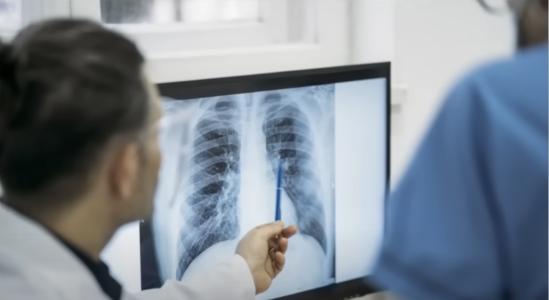You’ve heard of it—but you may not realize how deadly it still is
- Replies 0
In an era where many illnesses are front and center in the news, some continue to spread quietly—just as dangerous, but far less discussed.
One such threat has been around for generations, yet it still affects millions each year and remains one of the top infectious killers worldwide.
Its symptoms can hide in silence, and by the time it reveals itself, it may already be doing serious harm.

“Since its identification in 1882, over 1 billion people have died from tuberculosis, making it one of the deadliest infectious diseases in human history,” said Dr. Richard Doyle, clinical assistant professor of emergency medicine at Northwestern University.
These numbers aren't just historical statistics—they’re happening now, and the risk still touches every part of the world.
Its threat lies not only in its severity but in how quietly it can progress. The disease unfolds in three phases: primary, latent, and active.
The early stage often has few symptoms, sometimes just a light cough or low fever.
In the latent phase, the bacteria remain in the body without causing any signs of illness—making it easy to miss. But once active, TB can become a life-threatening illness if left untreated.
More like this: Discovery in US bogs could revolutionize tuberculosis treatment!
“Only about 5% to 10% of people infected with TB develop the active form of the disease,” said Amira Roess, professor of global health and epidemiology at George Mason University.
When that happens, symptoms often include a chronic cough, weight loss, fever, night sweats, loss of appetite, and in more severe cases, coughing up blood and serious chest pain.
TB’s ability to spread adds another layer of urgency. It travels through airborne particles—released when a person with active TB coughs, sneezes, or even talks.
“This is why we often see large-scale outbreaks in crowded or closed settings,” Roess explained.
Thankfully, only those with active TB can pass it on to others. But without knowing you’re infected, you may not recognize when you’re at risk.
“Most people respond very well to treatment,” noted Dr. Cathy Hewison, a tuberculosis advisor at Médecins Sans Frontières.
But treatment requires commitment. Side effects, long duration, and medication fatigue can lead to missed doses—giving the bacteria a chance to adapt.
If TB becomes resistant to drugs, treatment becomes more complex. Therapy can stretch to 18 months or longer and may involve harsher medications.
“Treatment should always first be guided by drug susceptibility testing,” Dr. Doyle stressed. This ensures the medications are tailored to the specific strain of TB involved.
More like this: Breakthrough discovery: How scientists are overcoming drug-resistant tuberculosis
“If the infection is caught early and if a patient adheres to their medication,” Roess said, “tuberculosis can be easily cured.”
Yet because symptoms often take time to appear—or are mistaken for common illnesses—diagnosis is sometimes delayed.
If you’ve been exposed to TB or notice persistent symptoms such as unexplained weight loss, a lingering cough, or fatigue—speak with your doctor. The earlier it’s addressed, the easier it is to treat.

Have you or someone you know ever been diagnosed with tuberculosis? What advice would you offer others navigating this illness—or hoping to avoid it? Share your experiences and questions in the comments below.
Read next: What was meant to protect her, only led to more danger: How did this woman contract the "world's deadliest" virus?
One such threat has been around for generations, yet it still affects millions each year and remains one of the top infectious killers worldwide.
Its symptoms can hide in silence, and by the time it reveals itself, it may already be doing serious harm.
A Global Killer That Never Left
Despite advances in medicine, tuberculosis (TB) continues to be one of the deadliest infectious diseases in the world. According to the World Health Organization, it kills about 1.25 million people every year. Over 10 million more are infected annually.
Tuberculosis (TB) continues to be one of the deadliest infectious diseases in the world. Image source: Good Morning America / YouTube
“Since its identification in 1882, over 1 billion people have died from tuberculosis, making it one of the deadliest infectious diseases in human history,” said Dr. Richard Doyle, clinical assistant professor of emergency medicine at Northwestern University.
These numbers aren't just historical statistics—they’re happening now, and the risk still touches every part of the world.
What Makes TB So Dangerous?
Tuberculosis is caused by the bacterium Mycobacterium tuberculosis. It primarily attacks the lungs but can spread to the brain, spine, and other organs.Its threat lies not only in its severity but in how quietly it can progress. The disease unfolds in three phases: primary, latent, and active.
The early stage often has few symptoms, sometimes just a light cough or low fever.
In the latent phase, the bacteria remain in the body without causing any signs of illness—making it easy to miss. But once active, TB can become a life-threatening illness if left untreated.
More like this: Discovery in US bogs could revolutionize tuberculosis treatment!
“Only about 5% to 10% of people infected with TB develop the active form of the disease,” said Amira Roess, professor of global health and epidemiology at George Mason University.
When that happens, symptoms often include a chronic cough, weight loss, fever, night sweats, loss of appetite, and in more severe cases, coughing up blood and serious chest pain.
A Disease That Spreads Through the Air
TB’s ability to spread adds another layer of urgency. It travels through airborne particles—released when a person with active TB coughs, sneezes, or even talks.
“This is why we often see large-scale outbreaks in crowded or closed settings,” Roess explained.
Thankfully, only those with active TB can pass it on to others. But without knowing you’re infected, you may not recognize when you’re at risk.
Treatment Works—If Caught in Time
The good news: TB is curable. Most cases respond well to a consistent course of antibiotics that lasts four to six months.“Most people respond very well to treatment,” noted Dr. Cathy Hewison, a tuberculosis advisor at Médecins Sans Frontières.
But treatment requires commitment. Side effects, long duration, and medication fatigue can lead to missed doses—giving the bacteria a chance to adapt.
If TB becomes resistant to drugs, treatment becomes more complex. Therapy can stretch to 18 months or longer and may involve harsher medications.
“Treatment should always first be guided by drug susceptibility testing,” Dr. Doyle stressed. This ensures the medications are tailored to the specific strain of TB involved.
More like this: Breakthrough discovery: How scientists are overcoming drug-resistant tuberculosis
Why Early Detection Matters
Time is a critical factor in TB care. Catching the infection early drastically improves outcomes and reduces the risk of transmission.“If the infection is caught early and if a patient adheres to their medication,” Roess said, “tuberculosis can be easily cured.”
Yet because symptoms often take time to appear—or are mistaken for common illnesses—diagnosis is sometimes delayed.
What Our Readers Should Know
At The GrayVine, we know that awareness can save lives. TB may not make daily headlines, but it’s a health issue that affects people of all ages, especially those with weakened immune systems or limited access to care.If you’ve been exposed to TB or notice persistent symptoms such as unexplained weight loss, a lingering cough, or fatigue—speak with your doctor. The earlier it’s addressed, the easier it is to treat.
A Preventable Tragedy
Tuberculosis doesn’t have to be a silent killer. With awareness, testing, and early treatment, lives can be saved. But that starts with knowledge—understanding the disease, how it spreads, and what you can do to protect yourself and your loved ones.
Key Takeaways
- Tuberculosis (TB) is one of the deadliest infectious diseases, killing around 1.25 million people a year and infecting more than 10 million annually.
- TB is a bacterial infection that primarily affects the lungs, but it can also spread to other parts of the body. It's transmitted through airborne particles when an infected person coughs or sneezes.
- Most people infected with TB do not develop symptoms immediately; some may experience a primary phase with mild symptoms, followed by a latent phase where the infection is dormant. Active TB occurs when the immune system can't suppress the infection, and symptoms become apparent.
- TB is curable with a course of antibiotics that typically lasts four to six months, but treatment adherence can be challenging due to side effects and the length of treatment. Drug-resistant TB requires more extended treatments, emphasizing the importance of drug susceptibility testing for effective medication use.
Read next: What was meant to protect her, only led to more danger: How did this woman contract the "world's deadliest" virus?






